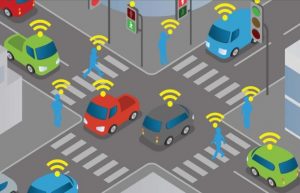Connected cars and the role of telematics in the future of intelligent transport
Undoubtedly connected cars are transforming the driving experience across Australia and the world. From driverless cars to real-time traffic updates and on-demand infotainment, telematics has endlesspotential to vastly improve the efficiency and safety, as well as the enjoyment of drivers on the nation’s roads.

The benefits of telematics do not only apply to the driver. Car manufacturers, for example,are able to use telematicsto build the brand experience and better understand customers. Whereas forauto insurance providers and fleet service managers, telematics can help make intelligent business decisionsto ultimately improve products and services such as lower insurance premiums and faster delivery of goods.
Ernst & Young predicts that 88 percent of all new cars globally will have integrated telematics by 2025.[1] Meanwhile, according to KPMG, half of all new cars sold today are connected and by 2030 all new cars on the road would have some element of connectivity, while a quarter would be fully autonomous[2].
The benefits that telematics will bring to drivers and businesses are limitless; however, here are four real examples on how telematics will transform the future of driving and intelligent transport systems:
- Smoothing traffic congestion
Connected cars have the potential to reduce the likelihood of traffic congestion on city roads and smooth traffic flow creating greater fuel efficiency and driver safety. Advances in connectivity such as in-vehicle diagnostics are steadily taking the guess work away from the driver. For example, Intelematics is currently building a solution for VicRoads that is expected to create smoother traffic flow by advising vehicles on the optimal travel speed needed to pass through a set of green traffic lights.
The technology works by using the data from the Victoria’s centralised traffic system to identify and share the green light sequence with drivers via either a dashboard or smartphone alert so that road users can adjust their speed to align with the green light cycle. Moreover, KPMG predicts that automatic braking systemslinked to connected vehicles could eliminate traffic jams by 2020[3]. With where technology is headed, we can expect road congestion to be thing of the past within the next decade or so.

- Providing actionable insights for insurers
The use of telematics provides limitless opportunities to convert data into insights and action. For car insurance providers in particular, the behavioural, traffic, and locational data that telematics can collectenable them to generate more intelligent risk forecasting in order to determine more customised premiums. Insurers are also able to utilise this vehicle connectivity to identify accidents in real-time – capturing a higher percentage of the repair business as a result and meaning they will be able to reach out to customers immediately. Subsequently, this reduces the leakage of repair work to independent repairers.
According to consulting firm, Ptolemus,almost 100 million vehicles will be insured with telematics policies, which will grow to nearly 50 percent of world’s vehicles by 2030. This is predicted to generatemore than $AU350 billion (equivalent) in premiums for insurers[4]. If we are to believe the figures, within the next 20 years we’ll be seeing car insurance policies that are based purely on driving behaviour rather than demographics such as age.
- Steering the driverless car revolution
Global production of self-driving cars is forecast to reach 14.5 million over the next 10 years, with more than 22 million of the vehicles expected to be in use by consumers in 2025[5]. As autonomous vehicles become more widely adopted, any accidents will most likely be treated as product liability claims. Whether the car is autonomous or not, telematics can pinpoint the causes of any incident or accident, so for manufacturers, telematics can provide the necessary information needed to develop better safety features.
For instance, if a driverless car is involved in a crash with a pedestrian or another car, the data gathered will be able to concludewho is liable – whether caused by human error, manufacturing fault or system glitch. With in-vehicle diagnostics and automatic braking becoming a reality however, the number of road accidents occurring on Australian roads will likely diminish over the next half century as human driven cars will slowly be replaced by autonomous ones.
- Improving fleet management services
Fleet services have traditionally been highly bespoke and expensive. However, widespread adoption of connected services in the consumer segment will disrupt the traditional model. While GPS technology can track an individual vehicle’s location, status and speed, this doesn’t enable the information to be detected across a fleet service. A fleet telematics solution is hence needed toenable vehicle tracking – providing a variety ofbenefits to businessesthat rely on rapid delivery of products and/or services. Moreover using information provided via telematics, fleet services can also better allocate resources; manage fuel and labour usage and costs.
More intelligent insurance pricing, more safety and streamlined driving on roads, better fleet management and autonomous driving are just the start – the potential for telematics to revolutionise transport systems are endless. The automotive industry and government must continue to collaborate to take advantage of telematics in order to provide both historical and real-time data to create more intelligent infrastructure and services.
References:

